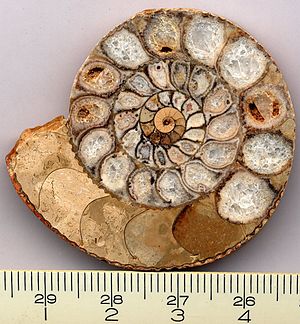Wise saints and drifting continents
 A round gray stone sits on my desk. The stone is cracked across the middle. It opens like a jewel box to reveal -- an ammonite, a fossilized sea creature shaped like the tightly coiled horn of a miniature ram.
A round gray stone sits on my desk. The stone is cracked across the middle. It opens like a jewel box to reveal -- an ammonite, a fossilized sea creature shaped like the tightly coiled horn of a miniature ram.The ammonite lived in the sea tens of millions of years ago. It died and fell into the muck on the sea floor. As time passed, its shell was replaced by stone.
I'll tell you in a moment where the fossil came from, but for now imagine picking up the stone that contains the fossil. Feel the heft in your hand, the river-worn convexity, the polish. The stone with its fossil treasure is a thing of visual beauty and tactile pleasure.
Fossil ammonites are not uncommon. Ammonites once inhabited Earth's seas in teeming numbers, some as small as dimes, others as big as automobile tires. One place where they occur in abundance is in the Jurassic sandstones and mudstones near Whitby on the North Sea coast of England.
The curious curled creatures in the rock could not help but evoke stories about their origin. In England during the Middle Ages the story often involved Saint Hilda.
Hilda was the 7th-century foundress and abbess of the convent at Whitby. She was a niece of King Edwin, and with him was baptized into the Christian faith by the first Christian missionaries to England. Her uncle died in battle in defense of the new faith, and Hilda was instrumental in consolidating English Christianity. She was a scholar, a patron of poets, a teacher and a wise counselor. Her spirit was in the background of the Synod of Whitby, at which leaders of the English Church adopted Roman liturgical practice and the monastic Rule of Benedict.
According to legend, Hilda turned snakes to stone -- a miracle that one-upped Saint Patrick who merely drove them out of Ireland. The creatures in the rock were serpents, the biblical manifestations of Satan, petrified by Hilda's saintly powers.
Today we have a rather different story to account for the "petrified snakes." It is a story that ranges over hundreds of millions of years and all of the oceans of the Earth. It is an evolutionary story that places ammonites squarely within the burgeoning tree of life, of which we ourselves are but a twig on a single branch.
My fossil ammonite was given to me by my geologist daughter. She brought it back from the high Himalayas -- far, far from Whitby and the presumed influence of Hilda. It is manifestly a sea creature, closely related to the chambered nautilus that swims in the oceans today.
One-hundred-and-forty million years ago a great supercontinent that comprised the present lands of Africa, Antarctica and India broke apart. India drifted northward, riding on moving slabs of the Earth's crust, from deep southern latitudes, across the equator, toward Asia. My ammonite swam in the ocean that separated India from Asia -- lived, died, and was buried in limey sediments on the floor of the sea.
As India approached Asia, the floor of the intervening sea was pushed down into the hot interior of the Earth under Asia. The seafloor sediments containing my ammonite were scraped off the oceanic crust and plastered onto Asia.
Sixty-five million years ago an asteroid slammed into the Yucatan Peninsula of Mexico and raised a cloud of dust into the atmosphere that cast the Earth's surface into cold and darkness. Photosynthesis ceased, food chains collapsed, and dinosaurs and ammonites became extinct, along with many other plants and animals.
Then, about 40 million years ago, India and Asia collided. The continental rocks were too thick and too buoyant to follow the diving seafloor back into the Earth's interior. They were heaved up into a towering mountain range, the Himalayas. The limestone containing the fossilized ammonite was caught in the wreckage of continents and thrust skyward.
The mountains began to erode, and eventually a chunk of limestone fell into a river. It was tumbled, rounded and polished. Someone found it, and split it open along a seam revealing the fossil. Eventually, it made its way to me.
The fossil tells a marvelous story of drifting continents, asteroid collisions, mountains thrust upwards, and wasting erosion -- a story of a planet that is constantly remaking itself, an epic drama of life evolving on a dynamic stage.
Does the new story of fossil ammonites detract from Hilda's legacy? I think not. She was an extraordinary woman, a shaper of her times, sometimes called the Mother of English Literature. To deny her the ability to turn snakes to stone does not diminish her significance by a whit. Rather, we see her exceptional talents for what they were: human, brave and creative. She stands even taller without her miracles.
A species of fossil ammonite, Hildoceras, has been named for the holy scholar -- abbess of Whitby -- an honor that in the long history of human learning will stand her in better stead than a whole seacoast full of "petrified snakes."


Comentários